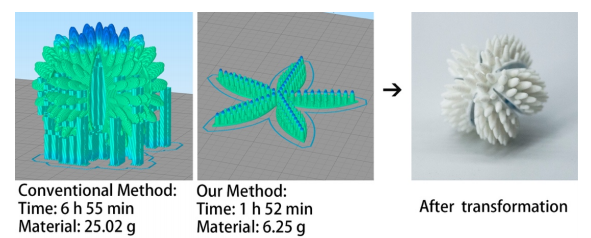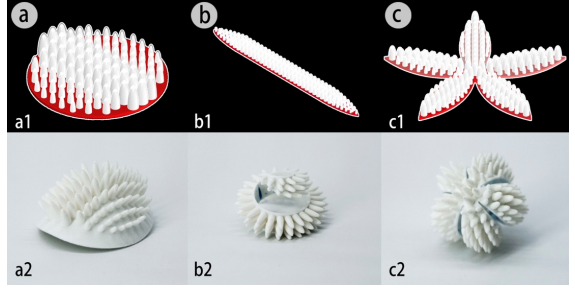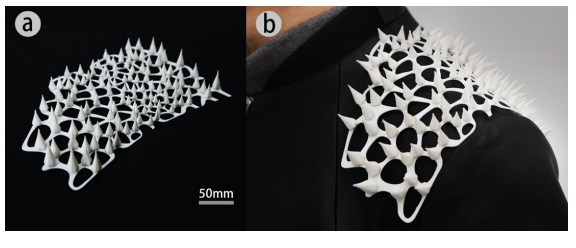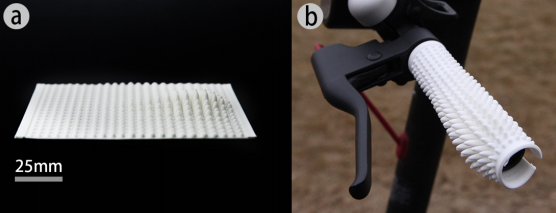Researchers from both the US and China are taking digital fabrication and texture in materials to the next level, releasing the findings of their study in the recently published ‘4D Texture: A Shape-Changing Fabrication Method for 3D Surfaces with Texture.’
4D printing is growing as an area of interest for many researchers, but like 3D printing—and even more so—there is still enormously uncharted territory. Users are able to move beyond the constraints of 3D printing to meet pressing needs for more complex projects like creating new metastructures, surfaces, and new materials and techniques. 4D printing offers more to users innovating beyond the 3D, seeking to fabricate more complex geometries too.
In this study, the authors introduce a new design approach called 4DTexture which they describe as a ‘holistic computational design and fabrication method, leveraging the state-of-the-art 4D printing process to make 3D surfaces with texture.’

Shape-changing principle: the textured structure can be printed without a support structure, which can transform into a 3D textured shape after heat triggering.
While the benefits of 3D printing are and continue to be vast for industrial users, 4D printing opens up new areas for fabrication that usually cannot be explored through conventional technology either. The new technique created in this study allows for actuators to be made with vertical texture structures—later to be turned into more complicated forms. The system runs on Rhino with Grasshopper, comprised of the following for preview and customization:
- Texture element
- Arrangement
- Tendency and transformation type

The workflow: users can (a) design the element of texture and (b) the shape of actuator, define the transformation type and (c) the arrange type of the texture, (d) set the tendency of the texture, then (e) generate the g-code file which can be printed by an FDM printer, finally users can obtain (f) the printed flat piece which can be heat triggered into (g) the target 3D shape.
Experiments were performed on textured structures as the researchers built up a ‘library’ consisting of shapes like hemispheres, pyramids, and hemicylinders. The program offers tools so that parameters can be customized; for example, designers can use offered 4D morphing mechanisms from previous projects or modify the settings if needed. Once the actuator shapes are set, textures can be arranged. Height and size can be chosen, and users can also move textures.
PLA was used with a MakerBot Replicator 2X as the researchers printed sample textures using the defaults for the hardware, producing self-rising, self-coiling, and self-bending objects.
“The transformation mechanism can be controlled by the printing direction, which has been embedded into our system to simulate the behavior,” stated the researchers.
Just as 3D printing has allowed for a variety of different forays into fashion, 4D printing has too, bringing all the benefits of materials that can morph and shift as needed. In this study, the researchers fabricated fashion accessories, a modular toy, a haptic handle, and 3D fasteners.
“We hope such a system can expand the design opportunity of 4D printing technology with a hobbyist FDM printer,” concluded the researchers. “In the future, we plan to implement a systematic material experiment for improving transformation accuracy and fine-tune the parametric setting with Grasshopper to make the design tool more user-friendly. We also found that the texture structure can serve as a constrained layer which needs further investigation.”
What do you think of this news? Let us know your thoughts! Join the discussion of this and other 3D printing topics at 3DPrintBoard.com.
Subscribe to Our Email Newsletter
Stay up-to-date on all the latest news from the 3D printing industry and receive information and offers from third party vendors.
You May Also Like
3D Printing Unpeeled: New Arkema Material for HP, Saddle and Macro MEMS
A new Arkema material for MJF is said to reduce costs per part by up to 25% and have an 85% reusability ratio. HP 3D HR PA 12 S has been...
3D Printing News Briefs, January 20, 2024: FDM, LPBF, Underwater 3D Printer, Racing, & More
We’re starting off with a process certification in today’s 3D Printing News Briefs, and then moving on to research about solute trapping, laser powder bed fusion, and then moving on...
3D Printing Webinar and Event Roundup: December 3, 2023
We’ve got plenty of events and webinars coming up for you this week! Quickparts is having a Manufacturing Roadshow, America Makes is holding a Member Town Hall, Stratafest makes two...
Formnext 2023 Day Three: Slam Dunk
I’m high—high on trade show. I’ve met numerous new faces and reconnected with old friends, creating an absolutely wonderful atmosphere. The excitement is palpable over several emerging developments. The high...




































